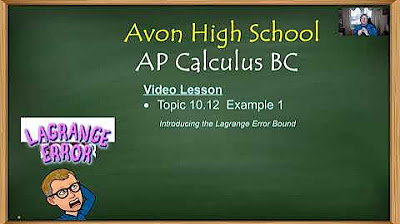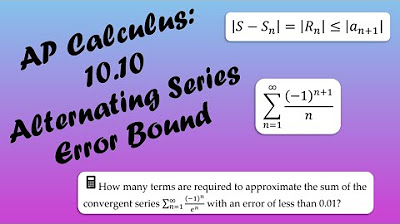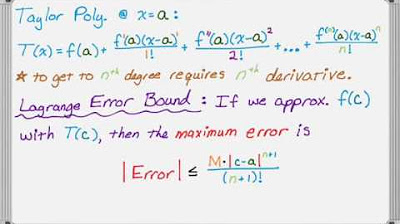AP Calculus BC Lesson 10.12
TLDRThe video lesson delves into the concept of the LaGrange error bound, which is used to estimate the maximum error in approximating a function with a Taylor polynomial. It begins with a review of the alternating series error bound and then explains the LaGrange error bound with detailed examples, including how to find the maximum value of the remainder and apply it to different scenarios. The lesson is informative and provides a solid understanding of these mathematical concepts.
Takeaways
- 📝 The LaGrange error bound is used for series that do not alternate, providing an upper limit on the error of a Taylor polynomial approximation.
- 🔢 The alternating series error bound states that for an alternating series converging to zero, the remainder is less than or equal to the absolute value of the first unused term.
- 📈 The LaGrange error bound formula is the absolute value of the remainder (R sub n of X) being less than or equal to the maximum of the (N+1)th derivative of F at x=z, divided by (N+1)! times (x-c)^(n+1).
- 🔍 To find the maximum value of the (N+1)th derivative, one can use graphical methods or direct values provided in the problem statement.
- 🌐 For functions like sine or cosine, the maximum value of the derivative is 1, simplifying the LaGrange error bound calculation.
- 📊 The LaGrange error bound is useful for determining the worst-case scenario error when approximating a function with a Taylor polynomial.
- 🧩 In practice, the error bound helps in understanding the precision of the approximation and when a higher degree polynomial may be necessary.
- 🔧 The process of applying the LaGrange error bound involves identifying key parameters such as the degree of the polynomial (n), the value of x, and the center of the Taylor polynomial (c).
- 📑 The script provides examples of applying the LaGrange error bound to various scenarios, including those with given maximum derivatives and those requiring graph analysis.
- 🎯 When solving problems, it's crucial to accurately identify the maximum value of the (N+1)th derivative to ensure the error bound is correctly calculated.
- 📈 The LaGrange error bound is a powerful tool in calculus for assessing the accuracy of approximations and can be used to prove specific inequalities, as demonstrated in the script.
Q & A
What is the LaGrange error bound?
-The LaGrange error bound is a method used to estimate the maximum possible error when approximating a function using a Taylor polynomial. It provides an upper limit on the error between the actual value of the function and its Taylor polynomial approximation.
How does the alternating series error bound differ from the LaGrange error bound?
-The alternating series error bound is applicable to series that converge by the alternating series test, where terms alternate in sign and decrease in magnitude to zero. It states that the remainder (error) is less than or equal to the absolute value of the first unused term. In contrast, the LaGrange error bound is used for series that do not necessarily alternate and provides an upper bound on the error for non-alternating series.
What is the Taylor polynomial approximation?
-The Taylor polynomial approximation is a polynomial that approximates a function based on its derivatives at a single point, known as the center of the polynomial. It is constructed by truncating the Taylor series after a certain degree and is used to estimate the function's value at points near the center.
What is the relationship between the remainder in a Taylor polynomial approximation and the actual value of a function?
-The remainder in a Taylor polynomial approximation is the difference between the actual value of the function and the value predicted by the polynomial approximation. It represents the error in the approximation and is used to quantify how close the polynomial is to the true function value.
How do you determine the maximum possible value of the remainder in a Taylor polynomial approximation?
-To determine the maximum possible value of the remainder, you calculate the absolute value of the (n+1)th derivative of the function at a point 'z' between the center of the polynomial and the point 'x' where the function is being approximated. This value is then divided by (n+1)! and multiplied by (x-c)^(n+1), where 'c' is the center of the Taylor polynomial.
What is the significance of the maximum value of the (n+1)th derivative in the LaGrange error bound formula?
-The maximum value of the (n+1)th derivative in the LaGrange error bound formula is crucial because it represents the worst-case scenario for the error in the Taylor polynomial approximation. It is the highest possible value that the remainder could be, given the function's behavior between the center 'c' and the approximation point 'x'.
How does the value of 'Z' affect the LaGrange error bound calculation?
-In the LaGrange error bound calculation, 'Z' represents a point between the center 'c' and the approximation point 'x'. The exact value of 'Z' is not known, but its presence in the formula accounts for the change in the function's behavior over the interval between 'c' and 'x'. The maximum value of the (n+1)th derivative at 'Z' is used to find the upper bound of the error.
What is the role of the factorial function in the LaGrange error bound formula?
-The factorial function in the LaGrange error bound formula, denoted as 'n+1 factorial', is used to adjust the magnitude of the remainder estimate. It ensures that the error bound decreases as the degree of the Taylor polynomial increases, reflecting the improved accuracy of higher-degree polynomials in approximating the function.
How can you find the maximum value of the (n+1)th derivative for a given function?
-To find the maximum value of the (n+1)th derivative for a given function, you would typically examine the function's properties or its graph. For some functions, like sine or cosine, the maximum derivative is known (e.g., 1 for sine or cosine functions). For other functions, you might need to calculate the derivative and find its maximum value over the specified interval, possibly using calculus techniques or numerical methods.
What is the purpose of the LaGrange error bound in practical applications?
-The LaGrange error bound is useful in practical applications where it is important to know the accuracy of approximations. It helps in determining how close the Taylor polynomial approximation is to the actual function value, which is crucial in fields such as engineering, physics, and computer science where precise calculations are necessary.
How does the degree of the Taylor polynomial (n) affect the LaGrange error bound?
-As the degree of the Taylor polynomial (n) increases, the LaGrange error bound generally becomes smaller, indicating a more accurate approximation. This is because higher-degree polynomials can capture more of the function's behavior, leading to a better fit and a smaller error between the approximation and the actual function value.
Outlines
📘 Introduction to LaGrange Error Bound and Alternating Series
This paragraph introduces the concept of the LaGrange error bound, following a brief review of the alternating series error bound from a previous lesson. It explains that while the alternating series error bound is useful for series that converge by the alternating series test, the LaGrange error bound is applicable for non-alternating series. The paragraph also outlines the definition of the remainder in a series and how it relates to the first unused term. The Taylor polynomial approximation and its components are introduced, emphasizing the difference between the actual function value and the polynomial approximation, which is represented by the remainder.
📙 LaGrange Error Bound Formula and Application
The paragraph delves into the LaGrange error bound formula, explaining its components and how it provides an upper limit for the error when approximating a function using its Taylor polynomial. It describes the process of finding the maximum possible value of the remainder, which is the difference between the actual value and the Taylor polynomial approximation. The paragraph also provides an example of how to apply the LaGrange error bound, including identifying key variables such as the degree of the Taylor polynomial, the value of x, and the center of the polynomial. It concludes with a worked-out example demonstrating the calculation of the LaGrange error bound for a given function and its approximation.
📙 Further Explanation and Examples of LaGrange Error Bound
This paragraph continues the discussion on the LaGrange error bound, providing additional examples and explanations. It covers how to find the maximum value of the N+1 derivative of a function, which is a crucial part of the LaGrange error bound formula. The paragraph also addresses different scenarios, such as when the function is a sine or cosine, and when the function is more complex. It includes a multiple-choice question example and explains how to use the given information to find the smallest value of K that satisfies the LaGrange error bound condition.
📘 Taylor Series Convergence and Error Bound Calculation
The paragraph focuses on the convergence of Taylor series and the calculation of error bounds. It presents a scenario where the Taylor series converges to a function F for all values of x and discusses the use of the third derivative to estimate the maximum error. The paragraph includes a graph of the absolute value of the third derivative and explains how to use this graph to overestimate the maximum value for the purpose of calculating the error bound. A specific example is provided, where the error bound is calculated for a second-degree Taylor polynomial approximation of a function at x=5.
📙 Proof of Error Bound for a Specific Taylor Polynomial Approximation
This paragraph presents a problem where the goal is to prove that the absolute value of the difference between a function and its fourth-degree Taylor polynomial approximation is less than a specific value. The paragraph outlines the given information, including the center and degree of the Taylor polynomial, and the value of x for which the approximation is made. It then describes the process of using the LaGrange error bound to set up an expression for the maximum error and how to use a provided graph of the absolute value of the fifth derivative to determine the maximum value for the error bound calculation. The paragraph concludes with the successful demonstration that the calculated remainder is less than the required value.
📙 Demonstrating the LaGrange Error Bound for a Fifth-Degree Polynomial
The final paragraph of the script focuses on demonstrating the LaGrange error bound for a fifth-degree Taylor polynomial. Given the center of the polynomial and the value of x, the paragraph explains how to set up the LaGrange error bound expression. It then describes how to use a graph of the absolute value of the fifth derivative to estimate the maximum value for the calculation. The paragraph provides a step-by-step breakdown of the calculation, leading to the determination of the error bound. The calculated error bound is shown to be less than the given threshold, thus successfully demonstrating the LaGrange error bound for the given approximation.
Mindmap
Keywords
💡LaGrange Error Bound
💡Alternating Series Error Bound
💡Taylor Polynomial
💡Remainder
💡Derivative
💡Absolute Value
💡Factorial
💡Interval
💡Polynomial Approximation
💡Convergence
Highlights
Discussion of the LaGrange error bound and its application in approximating function values using Taylor polynomials.
Review of the alternating series error bound from lesson 10.10, which provides a way to determine the upper bound on the error for alternating series.
Explanation that the remainder in a series is the difference between the actual value of the series and the partial sum approximation.
Introduction to the Taylor polynomial approximation and its relation to the remainder in the context of the LaGrange error bound.
Formula for the absolute value of the remainder R sub n of X in terms of the Taylor polynomial approximation.
Discussion on finding the maximum possible value of the remainder for the worst-case scenario in Taylor polynomial approximations.
Explanation of the concept of 'Z' as a value between X and C, which is used in the calculation of the remainder.
Presentation of the LaGrange error bound formula for the nth degree Taylor polynomial approximation.
Illustration of how to use the LaGrange error bound to find the maximum error in approximating the value of a function using a Taylor polynomial.
Example problem walkthrough demonstrating the application of the LaGrange error bound to a fourth degree Taylor polynomial.
Explanation of how to identify key variables such as n, x, c, and z from given information for using the LaGrange error bound.
Discussion on the maximum value of the N plus 1 derivative of a function and how it can be determined, especially for sine or cosine functions.
Procedure for calculating the LaGrange error bound using the maximum of the absolute value of the selected derivatives.
Example of applying the LaGrange error bound to a fifth degree Maclaurin polynomial for a sine function approximation.
Explanation of how to find the smallest value of K for which the LaGrange error bound guarantees a certain level of accuracy in approximation.
Use of the LaGrange error bound in solving multiple-choice questions involving Taylor polynomial approximations.
Demonstration of using the LaGrange error bound to prove a specific value of the remainder in a Taylor series approximation.
Application of the LaGrange error bound to functions with derivatives for all orders and real values of X, showing the absolute value of the difference between the function value and its Taylor polynomial approximation.
Transcripts
Browse More Related Video

Calculus BC – 10.12 Lagrange Error Bound

Avon High School - AP Calculus BC - Topic 10.12 - Example 1

7 | FRQ (No Calculator) | Practice Sessions | AP Calculus BC

AP Calculus BC Lesson 10.10

The Lagrange Error Bound for Taylor Polynomials

Worked example: estimating sin(0.4) using Lagrange error bound | AP Calculus BC | Khan Academy
5.0 / 5 (0 votes)
Thanks for rating: